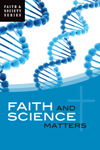
The “Big Bang”
 In honour of the announcement of Br. Guy Consolmagno’s reception of the renowned Carl Sagan Medal “for outstanding communication by an active planetary scientist to the general public,” we share with you a brief excerpt from his essay “Faith and the Cosmos” in our recently published book Faith and Science Matters. Consolmagno illustrates for us the influence of our metaphysical thought upon our perception of the physical world around us. He highlights the once-controversial scientific theory developed by the Jesuit priest-scientist Georges Lemaître. Consolmagno writes:
In honour of the announcement of Br. Guy Consolmagno’s reception of the renowned Carl Sagan Medal “for outstanding communication by an active planetary scientist to the general public,” we share with you a brief excerpt from his essay “Faith and the Cosmos” in our recently published book Faith and Science Matters. Consolmagno illustrates for us the influence of our metaphysical thought upon our perception of the physical world around us. He highlights the once-controversial scientific theory developed by the Jesuit priest-scientist Georges Lemaître. Consolmagno writes:
“This is the price we pay for our cosmology. But it means that, even today, the separation between what we study in the physical world and what we believe when we begin that study is much closer than most of us would like to admit. The physical and the metaphysical may be separate; but the metaphysical controls the way we choose to understand the physical.
Perhaps the most ironic modern example of how our assumptions about the universe colour the degree to which we are willing to accept the evidence of science is in the history of the idea that the universe is expanding from an initial point in time.
Newton’s insight that the falling apple and the orbiting moon obey the same laws of physics has been extrapolated into what is now called the cosmological principle: there is no privileged place in the universe. The laws of science are the same everywhere, and at every time. Indeed, this has long been extended to imply that the universe was without bounds in space or time.
Thus, when a Belgian mathematician, Georges Lemaître, suggested in the late 1920s that a universe described by Einstein’s Theory of General Relativity might in fact be expanding, his suggestion was treated with great scorn in many quarters. A universe where the space between galaxy clusters was actually growing implied that there must have been a time when that space was much smaller and the total energy density in the universe much higher. Indeed, Lemaître had postulated that one could calculate a specific point in time when the space between all matter was zero and the energy density infinite – a point that could be identified in some way as the “beginning” of the universe.
Speaking for the majority of cosmologists at that time, the English astronomer Fred Hoyle recognized that having such a special time in the universe was a direct violation of the cosmological principle. Even when the American astronomer Edwin Hubble discovered that distant galaxy clusters were in fact visibly moving away from us, in a manner completely in agreement with Lemaître’s suggestion, Hoyle responded by inventing an alternative model for the universe (involving the continual creation of space) rather than accept what he sarcastically referred to as Lemaître’s “Big Bang” theory.
We know the result, however. The overwhelming evidence from astronomy over the last fifty years has supported the predictions of the Big Bang and ruled out Hoyle’s alternative model. We now recognize that, in one sense at least, there was a time (if not a location) that was singular in the history of the cosmos.”
-An excerpt from Faith and Science Matters, Novalis Publishing, 2013.

